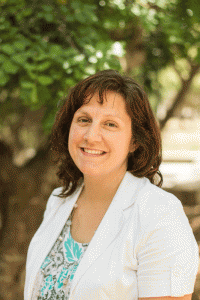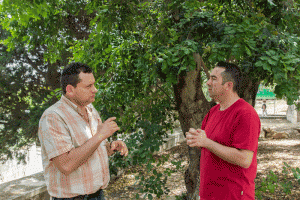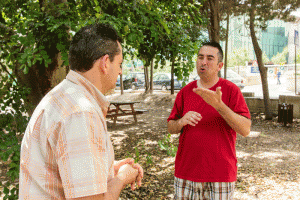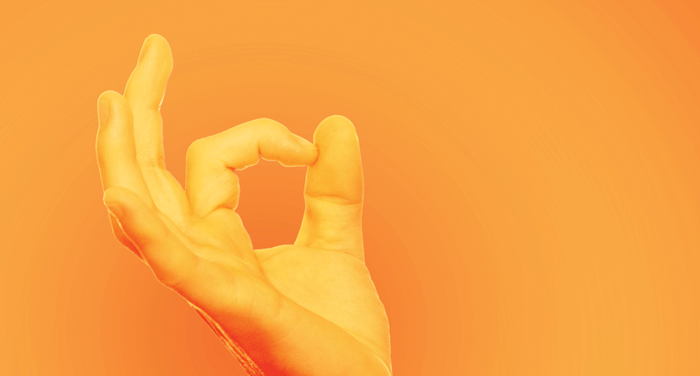Dr Maria Galea writes about her journey into the world of Maltese Sign Language and bringing a logical framework to the written form of the language. This work has the potential to empower the approximately 400 deaf people in Malta.

In the 1970s the ballerina Valerie Sutton was unable to pursue her passion for dance due to a life-threatening skin condition. Instead, she invented a notation system that allowed her to write body movements for dance choreography. This was the birth of DanceWriting. While Sutton was teaching at the Royal Danish Ballet, the sign language researcher Lars von der Lieth thought her system could be adapted to encode sign language. The same notation-system could represent hand-shapes and movements, spatial locations and orientations, as well as facial expressions and body movement. Sutton dedicated her life to the growth and spread of the writing system that can be used by deaf people all over the world.
Today the system has transformed into the fully developed International SignWriting Alphabet (ISWA 2010) used worldwide. It consists of 652 BaseSymbols required to write any sign language in the world. These SignWriting symbols represent distinct hand-shapes, their location and orientation in relation to the body, facial expressions, and movements that characterise sign languages. Deaf signers can represent signs in writing in the same way as words in spoken languages represent sounds. The main difference is that sign languages do not use the sounds, but instead use visuals and gestures to create units of meaning.
Maltese Sign Language
In Malta, around 400 people are born deaf. From these over 100 people are estimated to use Maltese Sign Language, which is the local sign language with its own hand gestures and other body movements. Worldwide, around 300 different sign languages are used. I learnt Maltese Sign Language from the Deaf community, and before I started my academic work, I was the first full-time sign language interpreter in Malta, hired in 2001 by the Maltese Deaf People’s Association which was founded in 1973. For years, I helped empower deaf people simply by interpreting and channelling their communication to be able to participate fully in Maltese society.
“It is hoped that this work will serve to continue to push towards their empowerment that can only be achieved if more interpreting services are made available.”
During this time, I also noticed how much deaf people enjoy being in each other’s company and use Maltese Sign Language spontaneously, a language I learnt and fell in love with as well. With SignWriting I saw the beautiful reaction of Deaf people as they discovered the relationship between signing and written signs, which corresponds to the relationship between spoken and written language. When they learn SignWriting they can express themselves in written form in their own language to write poetry, novels, or love letters if they wish. They have started to realise that their language is as important as spoken languages. All of this motivated me to start a doctorate in Maltese SignWriting.
In Malta, no one had ever undertaken a study in Maltese Sign Language at doctoral level. The grammar of this language had several aspects that still needed a description. My study attempted to use the study of the grammar to develop a language-specific SignWriting . My study helped establish an orthography (language-specific rules of a writing system) that built upon the previous publications, such as the Maltese Sign Language Dictionary volumes. A manual that instructs its users in the SignWriting of Maltese sign language was also completed. Deaf people find this very manageable and rewarding.
To this end, between 2008 and 2010, I worked on the Sign Language Research project of the Institute of Linguistics (University of Malta) to translate children’s stories into Maltese Sign Language. One publication was the Christmas story (on CD) that includes excerpts from the Gospels of Luke and Matthew. Such publications help increase literacy amongst the Deaf, who have the additional difficulty of never having heard how words are spoken as hearing people do. It is hoped that this work will serve to continue to push towards their empowerment which can only be achieved if more interpreting services are made available. These services would ensure access to the same opportunities as everyone else.
Let’s Agree
Reference to personal pronouns in sign language is based on three points in space. The first is a point on the signer’s body. The second a point straight ahead of the signer’s body. The third is a point to the side of the signer’s body. These points relate to the 1st (I/me), 2nd (you), and 3rd person (he/him) person. Now by pointing to these (with an index finger) a signer can create pronouns: me/I, you, and him/her. Coupled with this, there are a certain group of verbs in Maltese Sign Language that ‘agree’ with these points. The hands move towards these points and sort of ‘attach’ (or affix) to them. So in a verb like STAQSA (ASK), the hand is not an index finger shape but more like the handshape of the OK gesture produced by scuba divers. This hand can move to the different points in space and mean different things. So if the hand moves straight ahead it attaches to the 2nd person point and the result means ASK-YOU. On the other hand, if the hand moves to the side of the signer it attaches itself to the 3rd person point and the result is ASK-HIM/HER.
Maltese Sign Language agreement verbs need to be properly marked in SignWriting in order to be read with ease. This is because, within what looks like a single sign, often multiple elements can be marked. Just as the single Maltese word fakkarthiela (the equivalent in English of ‘I reminded her of it’) is made up of the verb ‘fakkar’ (to remind) ‘t’ (past tense plus 1st person singular ‘I’) ‘hie’ (feminine ‘it’) and ‘lha’ (to her), the same sign can simultaneously indicate subject, object, as well as adjectives and adverbs.
In some cases, simply writing the notation to indicate left or right does not adequately indicate to which person the verb refers. Pronouns and person marking on verbs are crucial. If these are not indicated in the written form, Maltese Sign Language cannot be read properly. Once these are clearly marked, subjects and objects of verbs—the ‘doers’ of actions or who did what to whom—can be identified.
“SignWriting evolved from a ballerina’s invention to write choreography, into a way to write many different sign languages across the globe.”
What is Signwriting? |
| Written Maltese Sign Language may look like hieroglyphs or Chinese script. However, this writing system has nothing in common with these. SignWriting is a featural writing system where every symbol represents a feature of sign language such as a handshape or hand movement. SignWriting resembles ancient Korean, where the symbols represent the actual physical articulation of the language. For example, in ancient Korean the ‘t’ sound would be represented by a symbol that shows the tongue touching the roof of the mouth that occurs in the production of the sound ‘t’. |
Sign linguists disagree whether agreement marking is properly indicated in grammar or whether agreement simply indicates where to point in space. If pronoun marking does not exist in a patterned systematic way, then some would argue that sign language is not actually ‘language’ (since a signer would be simply pointing to things). Whilst this was a controversial issue in the 1970s, most sign linguists are now open to sign language being both a mix of linguistic and gestural features. My findings push forward the argument that agreement marking is grammatical. It needs to be learnt and must be marked in the written form. This strengthens the argument that Maltese Sign Language is a complete language.
In order to disambiguate pronominals in signwriting Maltese Sign language, I introduced the adoption of an ‘anchor’ (a shoulder glyph). The combination of this anchor with another marker to identify different location points in space can show the different locations for 1st, 2nd, and 3rd person (right and left) points. This allows the relationship between the signer’s chest location and the pronominal points to become graphically clear; the signer can indicate exactly which action is happening to whom.
SignWriting evolved from a ballerina’s invention to write choreography, into a way to write many different sign languages across the globe. SignWriting is now so widespread that Sutton, the inventor, is no longer able to list and record all uses of SignWriting worldwide. SignWriting enables all Deaf people to write their native languages, and many languages already have large compilations of texts. The next step involved is the gradual establishment of the different alphabets and different orthography rules to write these different sign languages. My doctorate published the first manual that can help empower Maltese deaf people. What is needed now is a concrete push to help bring Maltese SignWriting to all Deaf people in Malta to build a bridge towards their move into literacy of the spoken languages, which is an indispensable tool for educational development.
For more information about SignWriting visit www.signwriting.org; www.signbank.org. The Ph.D. was carried out following the award of a STEPS (the Strategic Educational Pathways Scholarship—Malta) scholarship. This scholarship is part-financed by the European Union—European Social Fund (ESF) under Operational Programme II—Cohesion Policy 2007–2013, ‘Empowering People for More Jobs and a Better Quality of Life’.





Comments are closed for this article!